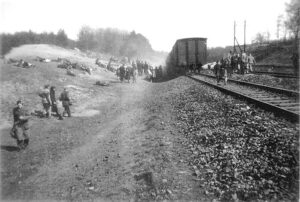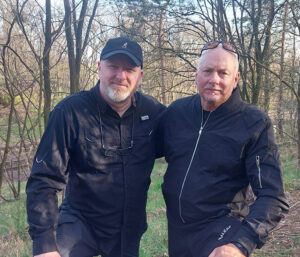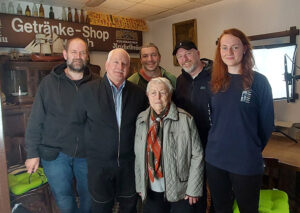By Matthew Rozell, Special to The Chronicle
Editor’s note: This is the second in a series, following Hudson Falls historian and retired teacher Matt Rozell’s documentary project on his best-selling book A Train from Magdeburg, about American solders’ liberation of Jewish Holocaust surviors in 1945.
On April 12, film director Mike Edwards and I drove in our rented BMW from near Bergen-Belsen concentration camp, to the city of Magdeburg on the Elbe River. Crew members Josh and Joel followed in another car.
We were greeted with a warm smile by 20-year-old Johanna Mücke, tall, with flaming red hair and impeccable English.
Four years prior, in 2018 at age 16, Johanna had written to me, asking if there were any American soldiers still alive that she could correspond with.

We put her in contact with Combat medic Walter Gantz of Scranton, Pa., who wrote with her until his death in 2019.
Now, Johanna was to serve as our translator and guide on this important part of the trip.
From the city — almost totally rebuilt after the World War II bombings — Johanna led us to the hamlet of Farsleben, 10 minutes from her former high school, where the train pictured on the cover of my book had been liberated.
Setting the stage
On April 12, 1945, the train had been abandoned by the engineer and guards.
American soldiers were nearby; the Red Army was nearing the Elbe River across from Magdeburg. That evening, the abandoned Jewish victims witnessed the most spectacular carpet bombing of the city of Magdeburg, a preparation for what was to be the final battle.
Some of the young went into the town begging for food. Most of its terrified residents shuttered their doors. Over 2,000 sick and hungry people had descended on Magdeburg.
A culminating moment
In April 2020 during the pandemic, a square granite monument inscribed with the insignia of the 30th Infantry Division, the date “April 13, 1945,” and “LIBERATION” in German, Hebrew, and English, had been unveiled, with the formal dedication postponed due to to Covid until the 77th anniversary — tomorrow.
I was scheduled to speak, and we were planning to film it. Today, my first time here, it was important to me to be at this site without the crowds.
This was a culminating moment of my life’s work. The recent local German awareness, the new monument and signage all traced their roots to our Hudson Falls interviews and reunions, stretching back two decades.

This had to be it!
Mike and the crew wanted to find the exact location where the train had been in our photograph, and from there, to make out the exact location where Amercan soldiers Walsh and Gross’s tanks had paused as their Major took the famous liberation photo.
As we walked back and forth on the ridgeline overlooking the ravine, through the trees that were not there in the 1945 photograph, a cargo train zoomed by. Josh filmed. The cars rushing by matched perfectly with the alignment of the train in the 77-year-old picture. On the opposite side of the ravine, hilltop and tree line matched perfectly over the top of the cars. This had to be it.
With ‘my guys’
The morning before the dedication ceremony, I found the access road that the tanks would have taken, where American soldier George Gross took many photographs after his tank was assigned to spend the night protecting the train.
Here was where my guys had been.
It was quiet, sunny, a breeze blowing through the locusts and the pines.
Seventy-seven years ago to the moment, at exactly that spot, people found salvation and tasted freedom.
A passenger train now rounded the bend as I neared the tracks. My heart raced with the long-ago soldiers at the blast of the wind, and I felt the sharp cry of the saved in their hour of deliverance as this modern day train shrieked past.
Survivor Leslie Meisels, age 18 at liberation, had recalled in interviews: “People were milling around outside of the wagons, talking about what had happened. Sometime around midday, I had made a fire from some twigs and I was starting to boil some of the remaining red beets in a pot when suddenly a huge cry went up.

“When I looked over to the top of that little embankment, I saw some dirty, sweating American soldiers — the most beautiful human beings imaginable — appear with their guns ready.
“Instead of the enemy, they found us and heard our screams and our cries of ‘Oh God, we are free! We are going to be human beings again!’…
Agi Baker, who had been 10, recalled: “The first sight I had of the Americans from inside the train was of a vehicle such as we had never seen before — it had a great white star on it, and someone familiar with that star said, ‘Oh my God, the Americans are here!’
“…The soldiers came, and were gentle, and gave us food.
“As I was a child, I fantasized that the soldiers were angels, with their wings hidden under their uniform shirts. Today I know that this was no fantasy; in that place and at that time the American soldiers were angels indeed!”
Because of our Hudson Falls project, both Leslie and Agi got to meet their liberators. Now I was at the site of their salvation, 77 years to the hour: We found it.
German community takes note
The following day, we filmed Johanna and some former classmates in their old history classroom.
Their teacher Karin Pederson had attended a lecture in the spring of 2018 by local father and son historians Daniel and Klaus-Peter Keweloh.
Daniel had written to me in 2008 from the German town of Hillersleben, some 15 or so km from the liberation site. During the World War, Hillersleben was the largest German military base for testing artillery, complete with barracks and a hospital. Hitler himself visited.
The base, captured also by U.S. forces on April 13, 1945, was where the liberated people were transported to get them cared for and out of harm’s way.
‘Stranded Train Committee’
Karin Pederson was brave to introduce her students to this history. They formed the “Stranded Train Committee” to create the signage and monument at the site.
There was some pushback, a knee-jerk fatigue of sorts by ordinary Germans feeling called to account for the crimes of their grandparents’ generation, at home and abroad. But more common was incredulity, bordering on outrage.
Since the publication of the liberator photographs in my book and on my website, survivors and second generation family members have been coming here to see the site of their liberation, or where their parents or grandparents succumbed and were buried.
How could there be nothing at the site to recall, honor and remember?
It was a thrill to see how they had picked up on my research and created something important.
Inviting survivors back to speak at their school, they made a bond with the first Jewish people they had ever met.
Walter’s nightmare
April 15, Easter Saturday, was grey, cold and overcast. With Johanna, we headed to Hillersleben to conduct interviews with Germans who were alive when the train was liberated.
This was the site of recurring nightmares for Walter Gantz, Johanna’s American contact. He had told us of working long shifts caring for the sick Holocaust survivors in Hillersleben.
“In the wee hours of the morning, this young girl died. For some reason, I wrapped her up in a blanket and I carried her down the stairs and I was crying.
“…I didn’t have to do that, because we had a team that took care of those who died and placed them in the morgue.
“…[This girl] was actually 15 years old. Her name was Eva, and you might say, ‘How was it possible that he could carry her?’ She probably weighed 60 pounds, maybe. I thought about that many times, and I must have been attracted to her for some reason. That haunted me, really. It really haunted me.”
The liberation had greatly affected Walter for the rest of his days. I know on a special level that the frienship with Johanna helped heal the trauma that he could not speak about for most of his life.
Full circle: Eva’s name
Hillersleben historian Daniel K. and his father took us to the now practically abandoned cemetery, surrounded by a sea of solar panels, where the hospital and garrison had been under first German, then Soviet occupation until the end of the Cold War. No individual graves were marked, but there was a memorial wall.
There, with Johanna present, we found Eva’s name. This German girl and her interest had been cathartic for the old American veteran, and now we stood before teenage Eva’s resting place.
Another circle had closed.
NEXT: TO OMAHA BEACH and the American Cemetery at Normandy.
Copyright © 2022 Lone Oak Publishing Co., Inc. All Rights Reserved
 Glens Falls Chronicle Serving the Glens Falls/Lake George region; Warren, Washington and northern Saratoga counties since 1980
Glens Falls Chronicle Serving the Glens Falls/Lake George region; Warren, Washington and northern Saratoga counties since 1980


